Woleai
Woleai is an atoll in the Western Caroline Islands.
Alternative spellings and historic names include: Anagai, Mereyon, Oleai, Ouleyai, Thirteen Islands, Uala, Ulea, Ulie, Uola, Woie, and Wolea
This coral atoll is situated at 7° 22' 19” N, 143° 54’ 20" E (on Falalop island), approximately 60 miles northeast of Eauripik and 32 miles west of Ifalik. It is about five and one half miles long (E-W), three miles wide, and 15 miles in circumference, It provides adequate anchorage for all types of ships and for seaplanes in a strategic location half way between Palau and Chuuk. Home to a runway, Woleai is roughly 423 miles southeast of Yap and 418 miles south of Guam.
The atoll is incomplete, consisting of an eastern and a larger western lagoon, each open on the south, There are also good passages in the north and west. The reef supports 23 islets, the most important of which are Raur, Paliau, and, Falalop in the east, Mariaon, Tagaula. Jalangigereil, Falalis and Seliap in the north, and Utagal and Falalis in the west. Woleai. Falalop is the largest islet and is triangular in shape. Raur was of considerable importance until it was devastated by the typhon of 1907.
Woleai was first recorded by the Spanish ship El Filipino in 1797, under Don Juan Lafita, while traveling from Manila to San Blas. The crew saw the atoll but did not land. The British merchantman Providence (James Wilson) also sighted the island later that same year, referring to it as “Wurlee.” The atoll was ; visited by Captain Samuel Bell of Boston in 1804; studied by Luis de Torres in 1804; and visited by Russian Friedrich Benjamin Graf von Lütke in 1828 and Andrew Cheyne in 1844.
Woleai is a part of the Outer Islands of Yap in Yap State, within the Federated States of Micronesia.
Subunits
Islands within the atoll include: Falalop (Furarappu, Mereyon or sometimes Woleai), Falalis (Falalis), Wottegai, Seliap (Saliap), Tagaula (Tagaulap), Mariyang (Mariaon) Paliau, Raur and Utagal
Population, Language and Religion
The 2010 FSM Census reported a population of 1,039. Woleaian is the spoken language and religious affiliation is predominantly Roman Catholic.
A 1935 count of the population by the Japanese identified 570 residents and one Japanese national. After the war, in summer of 1946, the US Naval Military Government counted 392 local residents on Woleai.
Governance
Spain laid claim to the Carolines from the time of initial discovery in the early 1500's but made no attempt to occupy or administer them. In 1885 a Governor for the Carolines was appointed by the Governor General of the Philippines and presence established in Pohnpei and Yap. In this Spanish Period (1521-1899), Woleai fell within the Western District of the Spanish East Indies.
After the Spanish-American War, Spain sold the Palau, Caroline, and Marianas Islands to Germany in 1899. In this German Period (1899-1914), the Caroline, Palau and Mariana Islands (excluding Guam), along with the Marshalls, annexed in 1885, were titled Imperial German Pacific Protectorates. The Carolines become an administrative district of German New Guinea under direction of a vice-governor and Woleaifell within the Eastern Caroline District.
The Carolines were seized from the Germans by the Japanese early in World War I. Despite protests from the United States, including the Yap Crisis, the Islands were in 1920 mandated to Japan by the League of Nations. In this Japanese Period (1914-1941), Woleai fell within the Yap District of the “Nan'yō Cho” or South Seas Government.
Following liberation of the islands in the War in the Pacific, the islands were administered by the US Navy. The Trust Territory of the Pacific Islands (TTPI) was formalized by United Nations Security Council Resolution 21 in 1947. The Navy passed governing duties to the Department of the Interior in 1951. During the USN Period (1945-1947) and the TTPI Period (1947-1979) Woleai fell within the Yap Administrative Unit and then the Yap District.
The Federated States of Micronesia (FSM) was established with the end of the Trust Territory. The FSM is one of three “Freely Associated States,” or “FAS” nations that entered into a Compact of Free Association or “COFA” with the US. The treaty and agreements provide economic assistance to the countries, secured US defense rights and set defense responsibilities, and allow FAS citizens to migrate to the United States.
Traditional Culture
Pre-Contact
Woleai was part of the "Yap-Ulithi-"Woleai" chain of authority and the related "Sawei" Yap/Outer Island Trade and Tribute Network (sometimes called the "Yap Empire”).
Pre-contact social order was characterized by: a social hierarchy with a strong egalitarian ethic and chief(s) with highly circumscribed powers (Goldman Level 1 of 3).; ; chronic warfare, defined as armed aggression between political communities or alliances of political communities, essentially continuously (4 on Younger's 0-4 scale).
Present Day
Traditional chiefly authority is exercised by the Council of Tamol.
In Yap, traditional leaders have a role in governnance that enshrines them as a "Fourth Branch." As John Haglelgam, former President of the FSM observed in his "Traditional Leaders and Governance in Micronesia" (1998), “in Yap, the traditional leaders have formal roles in the government. The Yap state constitution created two councils of chiefs: one for the main islands of Yap and one for the outer island chiefs. These councils are empowered to review and disapprove an act of the state legislature if it violates custom and tradition… The legislature cannot override the veto of these councils but can incorporate their objection in the bill and return it for their review. So far. the councils have used their power sparingly. The councils have also expanded their power to review policy of the executive branch which has forced the governor and his cabinet to justify their policy to the councils… The two councils are in essence public watchdogs, making sure that elected officials and bureaucrats are doing their job.“
Electoral Divisions
The legislative branch of the Federated States of Micronesia is unicameral. Two types of Senators are elected: at-large senators, one for each of the four states, who serve four-year terms, and population-based senators, representing specific constituencies, who serve two-year terms. The President of Micronesia is elected by the Congress from amongst the four at-large senators, after which a special election is held to (re)fill that seat. Woleai is represented in the FSM Congress by the Yap, At-Large Seat Senator, and the Yap, Sole Population-Based District Senator.
Since the establishment of the FSM, Yap State voters have elected and maintained in Congress one Yapese Senator and one Outer Island Senator. This de facto power-sharing arrangement is similar to the requirement in the Yap's State Constitution stating "if the Governor is a resident of Yap Islands Proper, the Lieutenant Governor shall be a resident of the Outer Islands, and if the Governor is a resident of the Outer Islands, the Lieutenant Governor shall be a resident of Yap Islands Proper."
Spanish and German Era
In 1893, the German Godeffroy Company extended it's copra operations to Ulithi, Ifalik, Lamotrek, Satawal, and Woleai, seven years after Pope Leo XIII awarded Yap and the Caroline Islands to Spain, but granted Germany and other nations commercial rights. Later, in the German Period, the Jaluit Company maintained a trading station on Woleai.
In July, 1902, the German administration on Yap instituted an arrangement whereby each of the eight chiefs of the island, in succession, was to send to the hospital an intelligent youth who would serve there for four weeks, after which he would return to his home equipped with a thermometer, cotton, bandages, salicylic powder, and a bottle of creolin. It was intended in this way to set up eight medical stations throughout the island, and eventually elsev;here, for the treatment of accidents and minor illnesses. The plan called for the holding of regular meetings every two weeks, at which the native assistants would make reports and receive further instruction. The first practical trial of this arrangement was with four natives from Woleai.
In 1903, German colonial administrator Arno Senfft visited Woleai as part of an inspection tour of the Western Carolines, documenting his observations. Senfft described the atoll’s traditional social and material culture, noting similarities with neighboring islands like Yap and Lamotrek while highlighting the continued use of indigenous housing, food production methods, and leadership structures. The visit served both administrative and symbolic purposes—asserting German authority over remote outer islands and gathering ethnographic data for colonial governance. Woleai, like other atolls in the region, was governed indirectly through local chiefs under Yap’s oversight.
In 1907, Woleai was struck by a devastating typhoon. A German ship stationed at New Guinea brought to Saipan about 300 people from Woleai had be. These people came and settled in a village in Saipan now known as Oleai village (San Jose). After Japan forcibly took possession of the islands in 1914, the Woleaians were returned to their atoll.
Japanese Era
A detached weather station was situated on Woleai during the Japanese Period. Information was relayed from these outlying stations to the Observatory at Koror, in Palau, seat of the South Seas Government.
Woleai was home to a naval radio station with the call letters JPO, located on the premises of the branch meteorological observatory. It was licensed to operate at a capacity of 500 kw,, used both A-1 a.nd A-2 types of transmission, and broadcasted on frequencies of 4,975, 6,100, and 8,955 kc. There was also a military wireless stations on Woleai.
Nanyo Boeki Kaisha had a branch office and two wooden piers were located in front of the office of the Nanyo Boeki Kaisha in the middle of the southern side of Falalop islet in Woleai atoll. There was also a pier at the southern extremity of the same island, and another on its northern side, but neither was secure. A small landing place was also observed on the southwestern shore of Falalop.
According to Japanese Captain Koseki, and Sergeants Okinaka and Hirano, seven thousand soldiers arrived on Woleai in April, 1944. They had come to man Woleai against threatened invasion, and to protect its airfield. Owing to regular bombing -daily, for 15 months- by the US, Koseki estimated that a mere 1,500 of these Japanese troops returned alive to Japan after the war.
Education
The Local Education Agency, or “school district” for Woleai is the Yap State Department of Education and Woleai falls within the Woleai Zone. The Neighboring Islands Central High School (NICHS) is located on Falalop, Woleai. There are community elementary schools, serving students in grades 1 through 8, on Falalis, Falalop, Seliap, Tegailap and Wottegai Islands.
Runway
Woleai Civil Airfield is located in Yap State on the largest island at the northeast corner of Woleai Atoll roughly 423 miles (681 km) southeast of Yap International Airport. It is intermittently served by Pacific Missionary Aviation. The runway is 1,200 by 75 feet of chipseal (asphalt over fine aggregate) and is in poor condition.
See also Woleai Airport.
Texts Dealing with Woleai
Alkire, William H. (July 1968). "Porpoises and Taro". Ethnology. 7 (3): 280. doi:10.2307/3772893. ISSN 0014-1828.
Alkire, William H. (1974). "Land Tenure in the Woleai". In Lundsgaarde, Henry (ed.). Land Tenure in Oceania. Honolulu, HI: University of Hawai'i Press. pp. 39–69.
Alkire, William H. (May 1984). "Central Carolinian Oral Narratives: Indigenous Migration Theories and Principles of Order and Rank". Pacific Studies. 07 (2): 1–14.
Kukelhan, Walter (2020-01-12). Japanese Surrender Woleai Atoll USS Sloat DE 245 (Report).
Peattie, Mark R. (1988). Nanʻyō: the Rise and Fall of the Japanese in Micronesia, 1885-1945. Honolulu: Center for Pacific Islands Studies, School of Hawiian, Asian, and Pacific Studies, University of Hawaii. ISBN 978-0-8248-1087-0.
Sohn, Ho-Min; Tawerilmang, Anthony (1976). Woleaian-English Dictionary. Honolulu, HI: University of Hawaii Press. ISBN 978-0-8248-8227-3.
Report of the German South Pacific Expedition 1908-1910 (Report). Translated by Petrosian-Husa, Carmen C. H. 2001. pp. 183–298.



